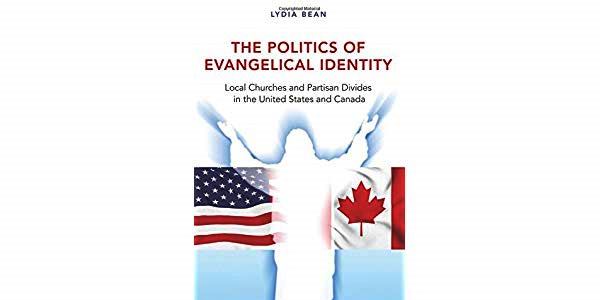
To Download click here.
How to Cite:
CHRISTOFIS, N. (2018), ‘BOOK REVIEW: The Politics of Evangelical Identity: Local Churches and Partisan Divides in the United States and Canada’, Journal of Global Analysis, 8(1): 100-103.
Lydia Bean
The Politics of Evangelical Identity: Local Churches and Partisan Divides in the United States and Canada
(Princeton University Press, 2014. ISBN 978-0-691-17370-2, 336 pp., $27.95 sb.)
The Politics of Evangelical Identity examines Canadian and American religious and political identity formation in evangelical communities, addressing the question of why the American evangelical identity is so closely aligned with partisan identity. By contrasting attitudes, discourses, and actors in both countries, Lydia Bean finds that the political identities and positions in evangelical communities of both countries are filtered through strict moral narratives. The factor of difference between the evangelical identities in these cases relates primarily to the dampening of alternative political discourses in the speech norms in American evangelical communities.
The analysis includes four church communities on either side of the New York and Ontario border, expecting that the differences caused by regional and geographic variations will be more effectively controlled within this proximity than comparative cases in other regions. To provide congruence for comparison, she examined two Pentecostal churches on either side of the border and two Baptist churches on either side of the border. This allows for nuanced findings between denominations that lend some insight into how the evangelical identity manifests in differences between both evangelicals and non-evangelicals, as well as between different denominations within the shared identity, and finally, between communities of the same denomination within two separate political contexts.
In the US, the alignment of the evangelical identity and the conservative Republican identity was aided by the Communist threat, which advanced secularism alongside its socialist economic ideology. In doing so, the evangelical imagination began to align the threat of secularism with liberalism. This alignment was furthered in the public and political contests that pitted American Christian values against those advocated by new secular humanists. The most influential of these incidents is presumably the Scopes trial, which was the harbinger of the evangelical cultural hegemonic decline in the United States. In the absence of these key junctures in the development of their identity, cultural threats in Canada have been much less formative. The result is an increased flexibility in how Canadian evangelicals position themselves on social welfare issues. This is not to say, however, that this difference extends to every political issue and policy domain.
In both the Canadian and the American evangelical churches, Bean found that the bounds of the group identity were drawn firmly on positions of abortion and homosexuality. However, the discourse norms observed in each of the churches indicate that politics are not considered an appropriate topic of conversation within the sacred domain of the church. So, while the bounds of American evangelical identity are shaped by positions on abortion and homosexuality, these issues are not politicized within the church itself. Instead, these issues are treated as spiritual, moral, personal, and ministry issues. This finding is a significant contribution to our current understanding of how political values are cued for evangelical constituencies. Prevailing assumptions regarding evangelical political behavior suggests that individuals are politically activated within the church and then mobilized in outside organizations, but Bean demonstrates that this process is reversed, and political awareness, issue cueing, and activation all happen outside the church first. Within the churches, however, Bean shows that political cueing comes more in the form of enforcing norms in dialogue. On the rare occasion when cues are delivered from the pulpit, they are more reflective of the understood political preferences of the congregants than they are an attempt to steer political values. Overt political cueing that Bean observed was primarily delivered by lay leaders within the church who worked to shape the churches’ social agendas and protect the established discourse norms rather than from the church ministers.
Rejecting the top down dissemination of political cues, Bean finds that lay leaders are the mechanism that connects the political positioning of congregations to political cues distributed through outside organizations and media. The lay leaders and the issues that they bring to the attention of the congregation promote service and participation in outside service organizations. Similarly, Christian media constructs the narrative by which evangelicals frame much of their political thinking by cueing the bounds of identity. Christian media teaches moral skepticism of the liberal or secular media, propagating a culture war mentality, and strengthening the alignment of political and religious identity bounds between partisanship and evangelicalism.
The scope of influence that is experienced in the formation and enforcement of identity bounds that Bean has identified is significant. One congregant that was interviewed demonstrated that it is possible for evangelicals to not identify at all in partisan or ideological terms, but that the identity that informs political positions is “Christian,” illustrating the primacy of this identity in the lives of Evangelicals. Another reported that her political positions changed when she joined the evangelical church. Her religious conversion instilled in her a new narrative of authority, discipline, and submission, which led her to reject her past lifestyle and liberal political values. Her religion gave her a distinct moral lens and the media aligned that morality with her political positions.
Points that remain unanswered in this study feature predominantly in the external sources. While the ethnographic data provided within the church communities is convincing, there are several significant external forces that differ in the Canadian and American political environments that likely prevail upon the outcomes observed. Not the least of these is the differences between the party systems in Canada and the US. While Canada operates from a multiparty parliamentary system, the United States is only a two party system, which might make these cleavages more likely to develop and polarize, likewise diminishing the ability to moderate identity alignments. In a similar line of thinking, the cultural warfare narrative often requires an opposition, so the liberal humanistic attitudes towards evangelicals in the United States might also have played a key role in this alignment as well.
Taken as a whole, The Politics of Evangelical Identity provides a major contribution to our understanding of how politics is received, translated, and activated within a major subculture of both American and Canadian politics. By situating herself within the specific contexts of evangelical communities, Lydia Bean demonstrates clearly and convincingly the mechanisms of evangelical politics that have been lost in studies conducted utilizing only aggregated survey data. This book will be of interest to Comparative Politics scholars, students of religion and politics, and American Politics scholars.
Rebecca Clendenen
University of Illinois at Chicago



